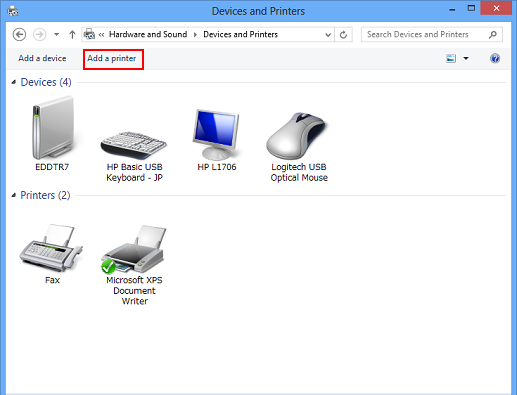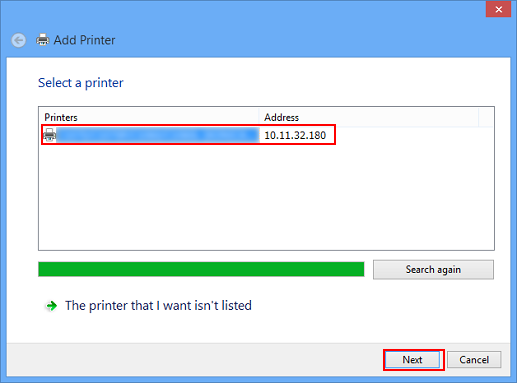For Network Connection (LPR/Port 9100/SMB)
In Windows 8/Server 2012, you can install the printer driver either by searching for the printer on the network, or by creating a new printer port.
Settings of this machine
To use Port 9100, LPR, or SMB printing, you must configure the network settings for the machine in advance.
Items to be configured | Description |
|---|---|
IP Address | In [TCP/IP Settings] of this machine, specify the IP address. |
RAW port number | To use Port 9100 printing: |
LPD Setting | To use LPR printing: |
SMB Setting | To use SMB printing: |
For details on the network settings for this machine, refer to NIC Setting: Setting the Machine Network Information.
To use SMB printing in the IPv6 environment, [Direct Hosting Setting] for the machine should be enabled. For details, refer to Direct Hosting Setting.
Designate the file for the printer driver provided in "EN (en)" folder of each printer driver contained in the Driver CD-ROM.
Installing the printer driver by searching for the printer using the Add Printer Wizard.
Installing the driver requires the administrator privilege.
Since the printer is searched for during the installation, be sure to connect this machine to the network before turning it on.
Insert the Driver CD-ROM into the CD-ROM drive.
Right-click the Start window, and then click [Devices and Printers] under [All Applications] - [Control Panel] - [Hardware and Sound].
On the toolbar, select [Add a printer].

Select this machine from the list, and then click [Next].

To use the LPR/Port9100 protocol, select the printer with its IP address.
To use the SMB connection, select the printer with its "\\NetBIOS name\print service name". You can check the NetBIOS name and print service name by selecting [Administrator Setting] - [Network Setting] - [Controller NIC Setting Menu] - [SMB Setting] - [Print Setting]. In the default setting, the last six characters of the NetBIOS name correspond to the low-order three bytes of the MAC address. To check the MAC address, select [Configuration Page].
For the SMB connection, click [Next], and then click [OK] in the [Connect to Printer] page that appears.
It may take some time to finish searching the entire list of printers.
Click [Have Disk...].
Click [Browse...].
Select a desired printer driver in the CD-ROM, and then click [Open].
Available printer drivers: PS Plug-in driver, PPD driver
Click [OK].
The [Printers] list appears.
Click [Next].

To use the SMB connection, click [OK].
Follow the instructions on the windows that follow.
If the [User Account Control] window appears, click [Continue] or [Yes].
Click [Finish].
After finishing the installation, make sure that the icon for the installed printer is displayed in the [Devices and Printers] window.
Remove the CD-ROM from the CD-ROM drive.
This completes the printer driver installation.
Installing the printer driver by creating a printer port
Installing the driver requires the administrator privilege.
Since the printer is searched for during the installation, be sure to connect this machine to the network before turning it on.
Insert the Driver CD-ROM into the CD-ROM drive.
Right-click the Start window, and then click [Devices and Printers] under [All Applications] - [Control Panel] - [Hardware and Sound].
On the toolbar, select [Add a printer].

[Add Printer Wizard] appears.
In the window showing the search result, click [The printer that I want isn't listed].
Click [Add a local or network printer manually].
Click [Create a new port:], and then select the port type.
To use the LPR/Port9100 protocol, select [Standard TCP/IP Port].
To use the SMB connection, select [Local Port].
Click [Next].
Specify the IP address and port.
To use the LPR/Port9100 protocol, select [TCP/IP Device], and then enter the IP address.
To use the SMB connection, enter "\\NetBIOS name\print service name" in the [Port Name] box.
Enter the same NetBIOS name and print service name specified in [SMB Setting] - [Print Setting].
Click [Next].
If Additional Port Information Required or [More Port Information Required] dialog box appears, go to Step 11.
If the [Install the printer driver] dialog box appears, go to Step 14.
Select [Custom], and then click [Settings...].
Change the settings according to the port, and then click [OK].
For LPR connection, select [LPR], and then enter "Print" in the [Queue Name:] box.
You must discriminate between upper and lower case letters when entering it.
For Port9100, select [Raw], and then enter a RAW port number (initial setting: [9100]) in the [Port Number:] box.
If both LPR and Port 9100 are enabled on this machine, the printer driver is connected to this machine using LPR.
Click [Next].
The [Install the printer driver] page appears.
Click [Have Disk...].
Click [Browse...].
Select a desired printer driver in the CD-ROM, and then click [Open].
Available printer drivers: PS Plug-in driver, PPD driver
Click [OK].
Click [Next].

Follow the instructions on the windows that follow.
If the [User Account Control] window appears, click [Continue] or [Yes].
Click [Finish].
After finishing the installation, make sure that the icon for the installed printer is displayed in the [Devices and Printers] or [Printers] window.
Remove the CD-ROM from the CD-ROM drive.
This completes the printer driver installation.

